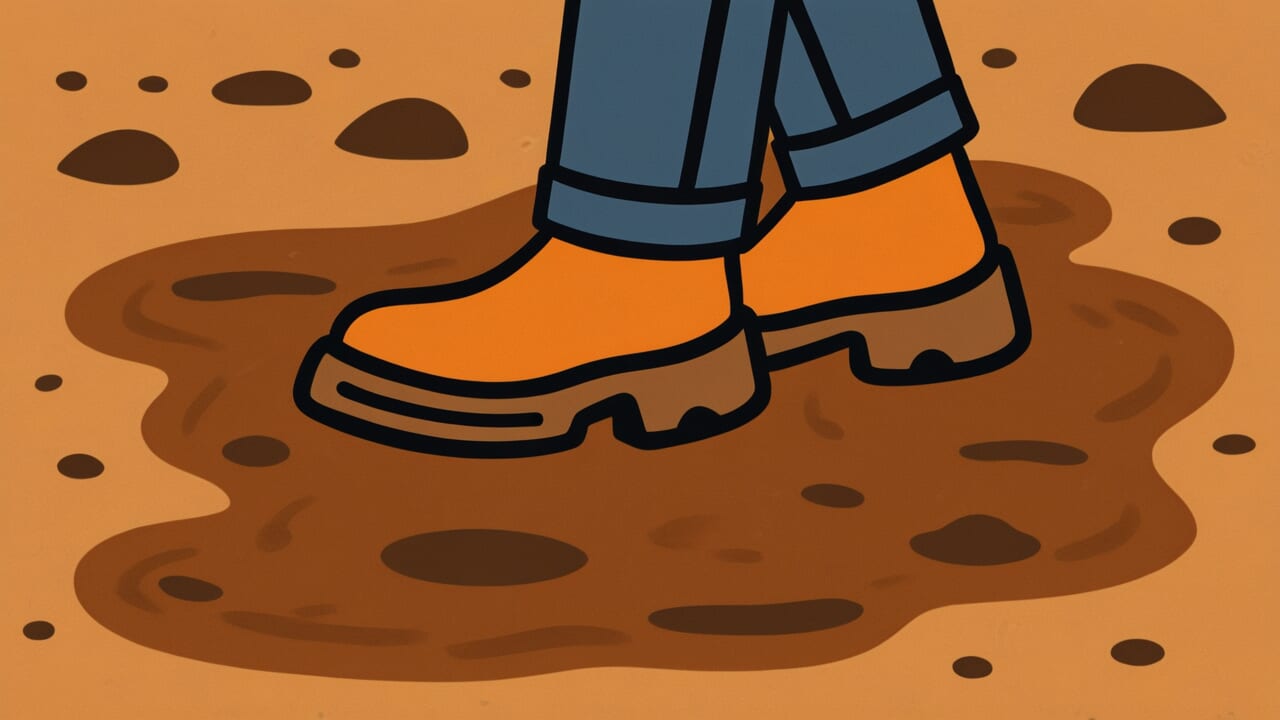How to Read “Walking feet gather mud”
Aruku ashi ni wa doro ga tsuku
Meaning of “Walking feet gather mud”
This proverb means that people who take action will inevitably face criticism or difficulties. If you stay still and do nothing, no one will complain about you and you won’t fail.
However, when you try something new or step forward to do something, there will always be people who disagree or unexpected problems that arise.
People use this proverb to encourage others not to fear criticism or difficulties that come with action. It’s also used to comfort someone who is being criticized.
The phrase is used in positive contexts like “Walking feet gather mud, so don’t worry and keep moving forward.”
Even in modern society, whenever you post something on social media or take action at work, you’ll get reactions. Some will be negative.
This proverb teaches us that it’s better to keep walking without fearing the mud than to do nothing out of fear.
Origin and Etymology
The exact first written appearance of this proverb is unclear. However, based on its structure, scholars believe it naturally emerged from the everyday experiences of Japanese people.
Before the Edo period, most roads in Japan were unpaved. When it rained, they turned muddy. Even on clear days, dust would fly up as people walked.
If you stayed quietly inside your house, your feet would stay clean. But the moment you stepped outside and walked around, mud would inevitably stick to your feet. This was a fact everyone experienced daily.
This ordinary phenomenon gradually became a metaphor for a life truth. Merchants, travelers, and people starting new ventures all faced this reality.
The more actively people moved around, the more they encountered various troubles or received criticism. This was just like how mud sticks to the feet of those who walk a lot.
What’s interesting is that this proverb doesn’t view mud as mere dirt. Instead, it sees mud as proof of action.
Having mud on your feet shows that you actually went outside and did something. It’s something to be proud of. This positive perspective is embedded in the saying.
Usage Examples
- When I proposed a new plan, some people opposed it, but walking feet gather mud, so let’s try it first
- Some people criticize her activities, but walking feet gather mud—those who do nothing can’t understand the struggles she faces
Universal Wisdom
This proverb has been passed down because humans are contradictory beings. We fundamentally seek safety, yet we also crave growth and achievement.
Nobody wants to be criticized. Nobody wants to fail and feel embarrassed. So many people try to avoid risks and live without standing out.
But at the same time, humans have a strong desire to accomplish something and test their potential. People constantly waver between these two conflicting emotions.
Our ancestors understood this human nature. Through “Walking feet gather mud,” they tried to convey one truth: action always comes with a price.
But this phrase also contains deep encouragement. Getting mud on your feet isn’t bad. It’s proof that you actually walked.
Things truly valuable in life are rarely easy to obtain. If you avoid the mud of criticism and difficulties, you’ll never reach important destinations.
This proverb teaches us that moving forward imperfectly is more valuable than seeking perfection and becoming paralyzed. The courage to not fear getting muddy is what drives human growth.
When AI Hears This
Let’s compare someone who walks 100 times with someone who walks 1,000 times. If the probability of stepping in mud per step is 10%, the person who walked 100 times steps in mud about 10 times.
The person who walked 1,000 times steps in mud about 100 times. In other words, the amount of mud isn’t just failure—it’s proof of the number of attempts. This is the “law of large numbers” in statistics.
The more you try, the more unavoidable events will occur based on probability.
What’s even more interesting is the Bayesian inference perspective. When we see someone with lots of mud on their feet, we tend to think “this person is careless.”
But the statistically correct inference is the opposite. Working backward from the amount of mud, this person has likely walked a considerable distance. The mud isn’t evidence of failure—it’s a reliable indicator of action volume.
The same phenomenon appears in corporate research and development. Companies with more patent applications actually have more failed projects too.
The success rate is the same, but because they try more times, both the absolute number of successes and failures increase. “Feet without mud” might actually be “proof of not walking.”
From a probability perspective, zero failures equals zero challenges.
Lessons for Today
What this proverb teaches us modern people is the courage to escape the trap of perfectionism. Now that social media is widespread, we’re constantly exposed to someone’s eyes.
If we fail even slightly, we get criticized and sometimes face online backlash. That’s why many people fear speaking up and avoid challenges.
But think about it. Among the people you respect, those who’ve accomplished something—is there anyone who’s never been criticized? Probably not even one person.
That’s because people who do work that moves hearts inevitably create both supporters and critics.
What matters isn’t avoiding mud, but continuing to walk even when mud sticks to you. When you receive criticism, try reframing it.
It’s not evidence that you’re doing nothing—it’s actually evidence that you’re doing something.
Of course, this doesn’t mean you should charge forward recklessly. But if you wait for perfection, nothing will ever begin.
Don’t fear a little mud and take that first step. The mud that sticks will naturally fall off as you keep walking. The mud on your feet is proof that you’re living.



Comments